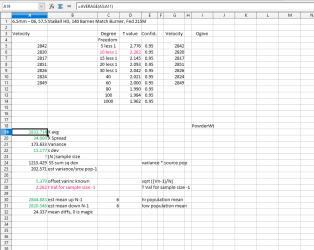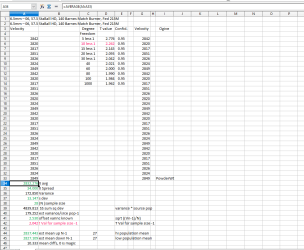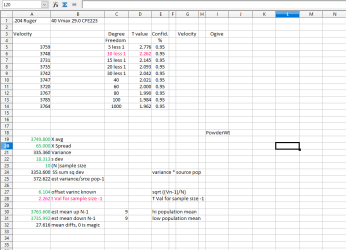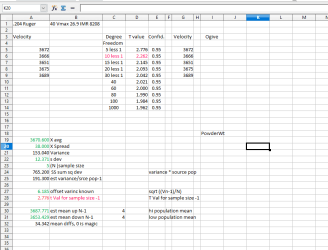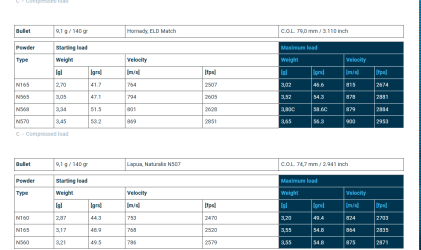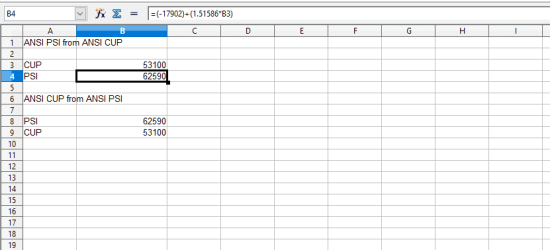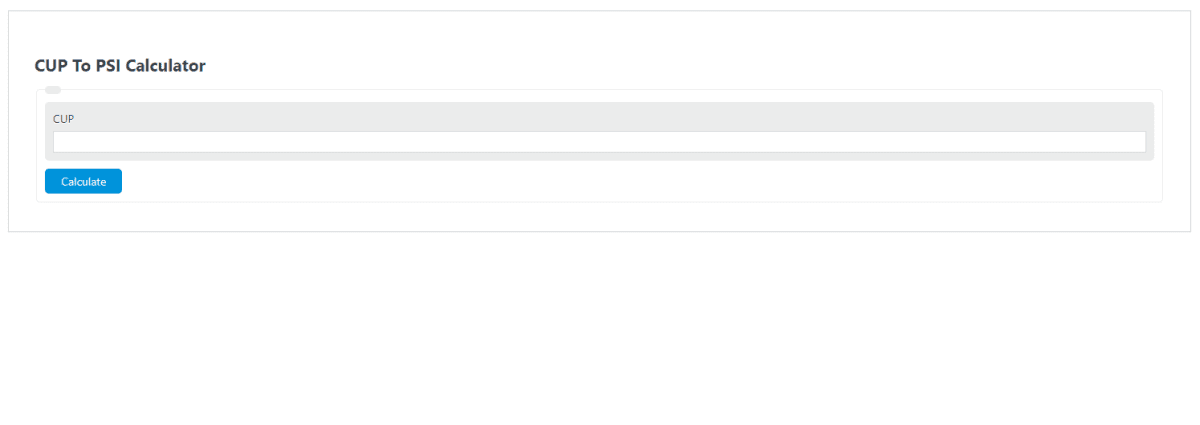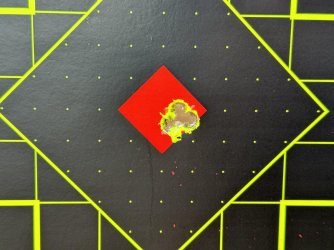My buddy and I have been working together on load development for our rifles; his is a 6.5 PRC. In load testing I found a velocity flat spot with my 243, also with good POI, but he has not.
Twice now with once-fired Lapua, his powder charged different loads have tracked Gordons Reloading Tool almost exactly. No nodes. The first ladder was 0.010 off the lands with a IMR7828SSC. The second, ladder was with H4831SC, and 0.070 off the lands. He's using Fed 215M primers, producing ~50 ft/sec higher velocities than non-magnum primers (which GRT predicted), and 147 gr ELDM's. At test range of 100 yds, he produced the lowest vertical dispersions with loads 2, 5, and 7 (see chart below); and corresponding velocity SD's of 12.0, 8.9, and 4.6.
Questions:
With 0.6 gr between loads, why were there no discernible velocity flat spots, see graph - average velocities linear with powder charge increments?
He's got a carbon barrel--does the carbon damp out the harmonics/resonance of the barrel? We'd appreciate any advice you can lend.
Velocity Curve vs H4831SC w/ GM215M primers
View attachment 511077
Vertical dispersion - ignore Load 1 and load 10
View attachment 511078
I have 4 6.5 PRC 3 of the 4 have Carbon Bbls
2 Factory Savage 110 with factory 24" Proof
Bbls 1 with a MDT Hnt 26 folder
1 in an MDT XRS Chassis
1Tikka T3x in a MDT ACC chassis 26" Bartlien
Carbon
1 Tikka T3x 28" Bartlien Heavy Senduro
All shoot well with the same load with Hornady 140 ELDM. All sub 1/2 in at 100
All have great performance I only did load development with this bullet on one the first 2 rifles and they just worked beautifully in all 4 so I counted my blessings and moved to trying drive myself insane with experimenting
With every other 6.5 bullet I could get my hands on

beginning in fall off 2020
My quest for the best possible load found me investing in Hornady, then Nosler, then Peterson and finally what I wanted all along Lapua brass, and 1000 of each of the following bullets ( so when I found the holy grail load every thing would be from the same lot…)
In short well ok long but it was a great learning experience and here is what I learned
First to note I like speed ! The faster the bullet get to the target the less time the wind has to push it around
My goal was to bump into the max speed for PRS of 3200 with what ever load I would land on ….
Berger 130, 140 hybrid 140 hunter ( 144 best of the Berger ) 156 LR hybrid
Hornady 135 & 153 Atip 140 & 147 ELDM
143 ELDX
Lapua 136 Senar II
Sierra 142 TMK and 150 MK
Powder tested RL 23 RL26 Sta-Bal 2 variants
and the new Gucci IMR powders and a couple more I would have to refer to my notes
and WRL, WLRM, Fed LR, Fed LR match,
Fed LRMag Match
What's interesting matches with my previous experiences with 6mm creedmore and recent experiences with 6mm ARC
Each Combo I tried I found a fantastic load for each rifle but ….
That load did not perform nearly as well in the other sibling rifles except….***
144 Berger in Lapua brass with 57.2 RL26 from the 28" pipe was the best consistent
Group of all tested yielding at .25ish groups at 100 but in the other rifles it opened up to 1 in or more
The Sierras didn't glow in any combo best was .77
The Lapua 136 Scenar II were also a one rifle wonder
In the end *** the ELDM and ELDX 140 143 and 147 shoot very well in every rifle
Best group is .370 but the worst is still sub 1/2 in at 100 from all 4 rifles
The go to load ended up to be
140 ELDM with 57.5 RL26 in a Lapua case
w Fed LR match and flies at 3197 ish parents Lab Radar ( recently tested with the new Garmin Xero ) plus or minus 2 FPS
But the point of all those words was to share that I had 2 solid nodes with every test I did
One twords the top where I like to run and one about 150 to 200 FPS slower
All my tests are run .3 grain ladders
I load both a batch of Max and a batch of the step down ( I have found loads that perform
Well here in Wisconsin at 1637 elevation
at Max do not perform will at Raton NM or Logan Utah, SantaFe or other higher elevations ( that's a novel for another day )
I have been blessed with many tools to pursue that perfect load and in the end
Red may not be the choice for winning
a bench rest match with one tiny hole
But when you have multiple rifles it makes my very happy to grab one ammo tote and 4 rifles that I know will ring steel all day

